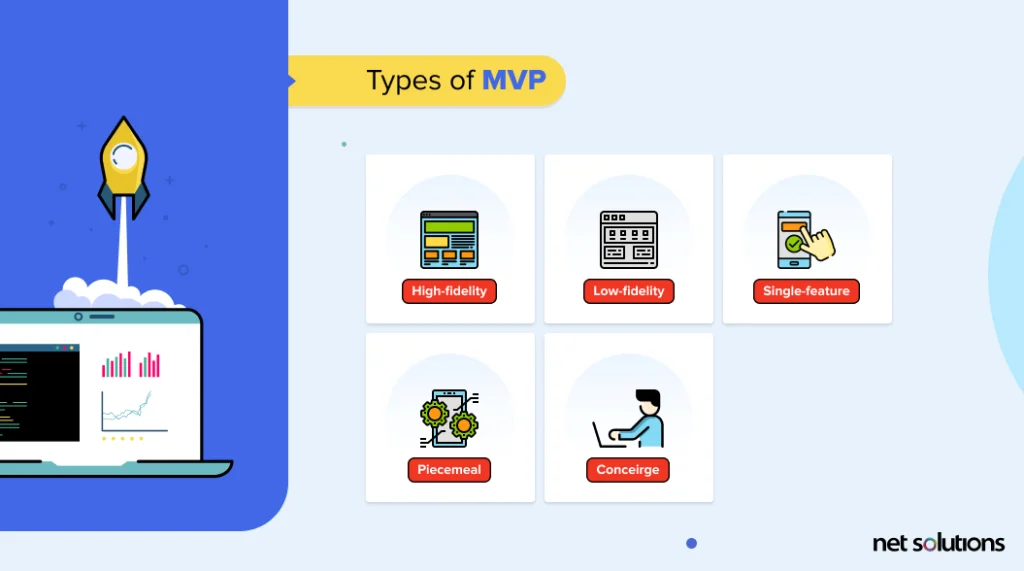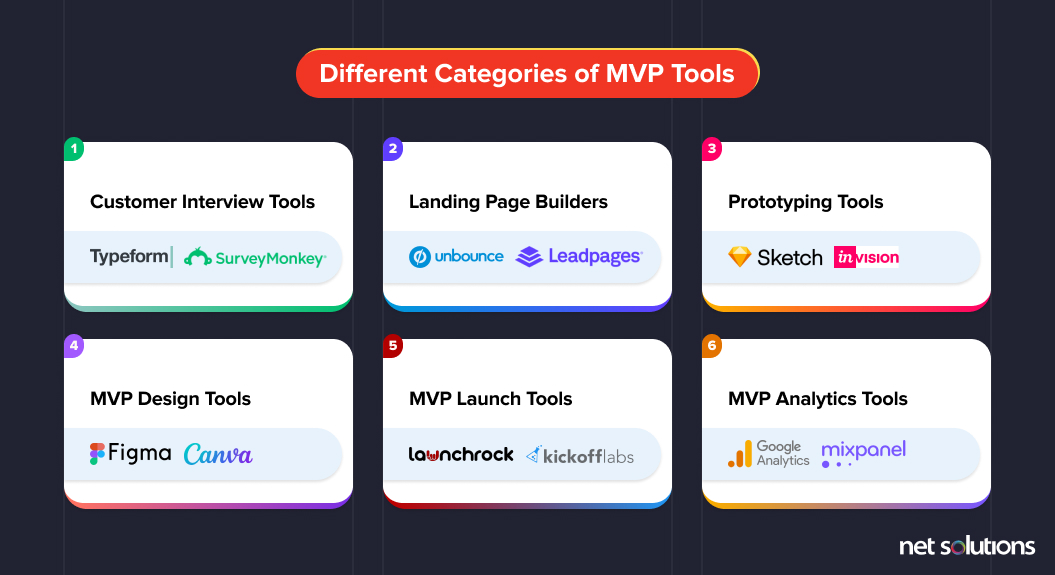Frank Robinson first introduced the concept of a Minimum Viable Product in 2001, and it’s now one of the gold standards for developing a marketable product from scratch.
MVPs offer a basic version of a software product, with features that are narrowed down to their most immediate functions. This is an excellent way to validate product ideas and gather feedback to inform future versions.
What follows is our guide to Minimum Viable Products, based on our many years of experience creating successful ones for our clients.
What is a Minimum Viable Product (MVP)?
A minimum viable product (MVP) is a stripped-down, low-risk software application that includes basic features and functionality that companies use to gather user feedback from early adopters.
The purpose of an MVP is to establish product-market fit with the least effort required, while including enough features to solve the problem the app is designed to solve. The MVP accomplishes this without spending large sums on features the market may not want. By validating product ideas before creating a complex version of a new product, entrepreneurs can ensure that the market needs what their product offers.
Based on feedback from real users, product teams can add new features in future iterations that meet customer needs and offer a powerful user experience. An MVP differs from a prototype in that the MVP is a fully functional software application, albeit a very basic one.
The main elements and characteristics of a Minimum Viable Product are that it:
- Has enough functionality to solve a key problem related to the software’s value proposition
- Hints at greater value to come in future versions—enough to attract and retain early adopters
- Offers a feedback loop, allowing product development teams to harness the wisdom of the crowd to build better products
A Minimum Viable Product comes with a whole host of benefits. Popularized by Eric Ries, author of The Lean Startup, there are numerous benefits to the MVP approach, including cost savings, risk reduction, faster time to market, and more.
Chapter 1 Types of MVP

There are many different types of MVPs that serve different purposes. Here are five popular ones.
- High-fidelity MVP: A high-fidelity MVP has limited functionality but presents a reasonably engaging interface.
- Low-fidelity MVP: A low-fidelity MVP has a very simple interface.
- Single-feature MVP: A single-feature MVP is a heavily stripped-down version, including only one feature—the product’s “killer app,” as it’s called.
- Concierge MVP: A concierge MVP uses a human being (or team of human beings) on the other end to fulfill processes that, in a full-fledged software product, would be completed automatically.
- Piecemeal MVP: A piecemeal MVP links to outside services and applications to fulfill certain tasks that will be fulfilled by the app itself in future versions.
Chapter 2 MVP Examples
What are some real-world examples of Minimum Viable Products? Here are three different MVPs for companies we all know well.
Dropbox: When Dropbox launched in 2008, cloud stage had been in use for a while, but small businesses were still getting up to speed. For their MVP, the founders of Dropbox created this video MVP explaining how their product worked.
Amazon: Jeff Bezos’ MVP was a simple website that served as a book-selling storefront. Customers placed an order, and someone handled it behind the scenes. No automation required!
Twitter: To test the world’s appetite for short, broadcasted messages, the Twitter MVP was a website that allowed people to send SMS texts to their friends. It was only offered to staff at Jack Dorsey’s first startup (Odeo). His team loved it, so they spent six months building Twitter.
As you can see, there are many different ways to approach an MVP.
Chapter 3 The Benefits of an MVP
Building an MVP comes with a whole host of benefits, making it an ideal option for many teams interested in introducing a new product idea to the market. Here are four of those benefits.
Faster Time-to-Market: MVPs are quicker to build than full-fledged products since they’re much simpler.
Gathering User Feedback: Customer feedback can help inform future releases, allowing you to focus on features that users truly value.
Cost Efficiency: The MVP methodology tends to be more cost-effective than launching a full-fledged product because software development teams don’t spend countless hours or waste resources building useless features.
Risk Mitigation: By focusing on core features, MVPs reduce risk by validating an idea and allowing companies to cut their losses before pouring money into the final product.
Chapter 4How to Build an MVP
A great deal goes into building an MVP before your developers ever begin coding. Here’s a brief overview of how to build an MVP, step by step.
- Conduct market research to understand what is currently on the market and what gaps might exist in the marketplace
- Brainstorm ideas to identify a unique problem you can solve
- Map out the user flow to identify each state of the customer journey
- Prioritize MVP features to decide what should appear in the first release
- Launch the MVP to gather feedback from your early adopters
- Build, Measure, Learn (BML) at each stage to create a product that is uniquely designed to serve your target market
Chapter 5Tools to Build an MVP
As MVPs have become the go-to method for creating new software, you can now access a whole host of tools that will bring your MVP to life. Here are seven broad categories of MVP tools.
Customer interview tools: These tools help you manage customer interviews at every stage, from finding interviewees to processing the data.
Landing page builders: Building a landing page can help you validate your MVP concept.
Prototyping tools: Build low-fidelity and high-fidelity prototypes to gather feedback.
MVP design tools: Design your MVP efficiently.
No-Code MVP tools: Automate key elements of coding.
MVP launch tools: Plan and execute your MVP launch seamlessly.
MVP analytics tools: These tools help you analyze your traffic, customer feedback, and more.

Chapter 6How Much Does an MVP Cost
As with any software product, the costs to build an MVP will vary greatly based on a number of factors. Here are some key factors that influence MVP costs.
Project scope and complexity: Factors like the total number of screens a user encounters, the programming involved in creating key features, and the user interface design will all factor into your MVP costs.
Technical requirements: From the tech stack to the cloud infrastructure, your technical requirements will impact your costs.
Design requirements: The amount of emphasis you place on User Experience (UX) and User Interface (UI) design will impact your costs.
Chapter 7MVP Testing
Quality Assurance (QA) testing isn’t the most glamorous part of software development, but it’s an essential part of the process, even for an MVP!
Here are some of the benefits that come with proper testing:
- Early error detection: Finding bugs early on will help you work more efficiently
- Long-term cost savings: Greater efficiency means reduced costs overall
- Proper security protocols: QA ensures that your clients’ data will be kept safe
- Improved User Experience: While MVPs don’t need to be perfect, they should provide as smooth an experience as possible
- Increased stakeholder confidence: Key stakeholders and investors don’t want to experience a bunch of bugs when testing the MVP
Chapter 8How to Launch an MVP
Launching isn’t the end of your MVP journey, it’s actually the first major step. Launching will validate your product’s viability in the marketplace, helping you refine your business model, understand your end users, and build a roadmap for feature sets to come.
Your project management plan should include the following items related to your launch:
- Go-to-market strategy (may include email campaigns, social media such as LinkedIn or Instagram, paid ads, and more)
- Metrics by which to measure success and evaluate your hypotheses surrounding market fit
- Plan to collect user feedback
- Careful discussions among key stakeholders to inform the product development process
- Plans to iterate and improve the product with each release
Chapter 9MVP Checklist
When it comes to product management for MVP design and development, we recommend using a checklist to make sure you’ve covered all your bases. While we don’t have space in this blog post to include the entire checklist, you can visit our Minimum Viable Product checklist blog post to see every step.
Checklists are helpful to keep your team on track and make sure you’ve addressed all the key elements required to increase your odds of success. Roadmapping software like Aha! and project management tools like Jira can keep your team on track.
Chapter 10Mobile App MVP
Creating an MVP for a mobile app is similar to creating an MVP for a desktop app, although you’ll have to decide early on whether you want to create a Progressive Web App (PWA) that works on all devices vs. a platform-specific app.
Mobile App MVPs require:
- Market research
- Brainstorming and ideation
- Understanding the customer journey
- Prioritizing features
- A clear launch strategy
- Evaluation and user feedback
- A product roadmap based on customer input for future releases
Chapter 11MVP and UX
When creating an MVP, it may be tempting to overlook User Experience (UX) principles. However, just because you’re creating a simple version of the product doesn’t mean it shouldn’t have a clear flow or fail to implement some basic UX principles.
Here are a few tips on creating a highly usable MVP:
- Prioritize speed and performance
- Emphasize simplicity
- Make your most important features easy to find and use
- Aim for consistency across all platforms
- Think clearly about user workflows and customer journeys
Chapter 12MVP for Startups
Startups are prime candidates for MVPs for a number of reasons. Here are three reasons why MVPs can be helpful for startups.
- Budgets are tight: Especially when bootstrapping, budgets are often slim for startups. Creating an MVP can save resources, which you can apply to future projects once you’ve validated your concept.
- New ideas require testing: Concepts like Uber and Amazon were radically new ideas in their initial stages. MVPs allowed their creators to make sure there was a market for them.
- Harness the wisdom of the crowd: There’s more innovation out in the world than there is inside a founder’s head. An MVP will help you create a product that users will come to love.
Chapter 13MVP Websites
Websites can serve a powerful role in your MVP product launch, either to announce your upcoming MVP or to serve as the MVP itself.
As a product marketing tool, you can create ads that link to your MVP website, which explains the upcoming product and collects email addresses for potential beta testers and early adopters.
When using an MVP website as the MVP itself, you can have people log into the website to perform whatever tasks they’d have the app perform. You can either automate those tasks from the website, or you can have someone manually fulfill a feature that you plan to automate in future releases.
Chapter 14The Role of MVP in Agile
The MVP methodology fits seamlessly into Agile principles since Agile is an iterative process—just like an MVP.
Just as Agile encourages feedback, revision, and collaboration, the MVP approach relies on feedback to shape new versions of the product following the initial launch. Agile developers are usually very familiar with MVP development, and Agile product managers can bring your product to life with minimal waste.
Chapter 15MVP Development Companies
When looking for a software development firm to help with your MVP, you’ll want to find a team that is experienced with MVP development. Here are a few tips on finding qualified MVP development companies.
- Vet all potential candidates and ask about their MVP experience
- Ask for case studies detailing work on MVPs
- Ask for customer testimonials related to MVP work
- Ask potential companies about their specific approach to MVP development
Try to find a team that takes a big-picture approach. Even if you’re only hiring them to support certain elements of your project such as QA or front-end coding, it’s helpful if they have experience in project management, research, and launching an MVP.
Need to Build Your MVP?
Net Solutions is a custom software development firm with nearly a quarter century of experience working at every stage of software development. We’ve designed MVPs for everyone from startups like Avance to large organizations like the Harvard Business Review.
Do you have a software product in mind that might benefit from an MVP approach? Schedule a free consultation today.
SHARE THIS POST
Table of Contents
Related Resources
- What Is an MVP App? A Guide to Building Successful Products
- A Deep Dive Into 7 Minimum Viable Product Benefits
- A Step-by-Step Guide to Build a Minimum Viable Product (MVP)
- 19-Step Minimum Viable Product (MVP) Checklist [With PDF]
- How Much Does a Minimum Viable Product (MVP) Cost? Here’s the Answer
- 10 Top MVP Development Companies [Great for Startups]
- 10 Minimum Viable Product (MVP) Examples You Should Know
- The Ultimate Guide to Developing an MVP in Agile: What, How, and Why
- A Step-by-Step Guide on how to Master Your MVP Launch in 2025
- How to Prioritize Features for Your Minimum Viable Product (MVP)
- How to Test an MVP: 15 Proven Strategies that Work
- 20 Great MVP Tools to Help You Create & Launch Your Product
- 11 different Types of MVPs to Kickstart Your Software Project
- How to Nail MVP Design with UX Design Principles that Work
- MVP Website: Benefits, Best Practices, How to Build & More

